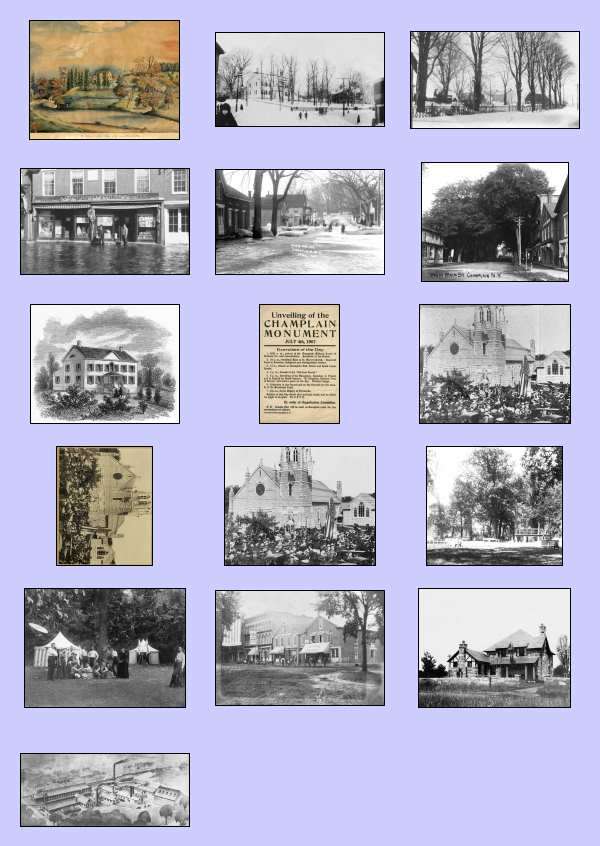2008 Champlain Historic
Calendar
The Settlement of Champlain and Building of the First Sawmill
May 23 to November 5, 1788
Part II
Pliny Moore was a 29 year old Revolutionary War soldier from the Albany area who founded Champlain, New York, in 1788. Prior to this time, he visited the area in March of 1785 to inspect the land and in October of 1786 to create a detailed survey. On February 6, 1787, the 119 lots in the 11,600 Smith and Graves Patent (also called the “Moorsfield Grant”) were balloted for by the State of New York in what was called the “Great Deed”. The 2007 Champlain Historic Calendar has an 11 page history that details these events and includes several important maps never before published.
The Selection of Tradesmen for the Building of Champlain’s First Sawmill
Before Pliny could settle Champlain, he needed to find tradesmen that could build him a sawmill. The sawmill would be needed to cut logs into boards so permanent frame houses could be built. He needed a skilled carpenter, blacksmith and laborers. These people did not necessarily have to be permanent settlers. In fact, half the men he would bring to Champlain in 1788 were only there to build his sawmill and fulfill their contracts with him. After the sawmill was completed in the fall, the men would go back to their homes near Albany.
Pliny made business proposals to several local tradesmen concerning the building of a sawmill. In March, Pliny talked to David Spencer of Stockbridge, New York. David wrote, in part, “You informed me that you would make some proposals Conserning business Next summer [May 1788] I am not att preasent Ingaged but have Good offers made me — neverthe less if your proposals Should bee agreeable likely we Shall Easely agree about matters…” David Barret, a carpenter, wrote Pliny on April 4 and stated, in part, “I understand you want me to Build you a mill at Lake Champlain and take a part in money and a part in land there I do not want land there. I can Do your work if you will give me ten Shillings a Day …..on these Conditions I will undertake your work and Do it well.”
The deal with both men fell through and Pliny continued his search for skilled laborers. He finally settled on two tradesmen: he hired Caleb Thomas as the blacksmith and Thomas Mors as the carpenter. Mors would later leave the settlement three months early after some discontent. Fortunately for Pliny, Caleb Thomas stayed and became a permanent settler. Lodewick Dickinson, Asa Callender and a man named “Guyl” were also hired as general laborers and would cut timber, build roads and help raise the sawmill. Pliny would later hire Amable Courtemanch to be his sawmill sawyer. Amable was a Canadian refugee who lived in the Canadian Settlement near the mouth of the Great Chazy River.
Departure for Champlain
Pliny Moore and his workers left Kinderhook, New York, on May 12, 1788, and traveled with two horses to Skenesborough (Whitehall). On the way, Pliny had to ferry the horses across water at Half Moon and Saratoga. At Fort Ann, he gave the horses to Asa Callender and continued his travel north by boat down Lake Champlain and through the mouth of the Great Chazy River. The official founding of Champlain started on May 23, 1788, after Pliny, some settlers and his workers arrived. Also accompanying Pliny or soon after were permanent settlers William Beaumont and his wife and Samuel Ashmun. Joseph Rowe, another of the first settlers, may have arrived in Champlain with his wife shortly before Pliny. Settler Elnathan Rogers came up to Champlain around August 25 as his presence is not noted before that time. Meanwhile, Asa traveled with the horses through Vermont to Colchester Point (Malletts Bay) where they were ferried to Isle la Motte on May 26. Asa finally arrived in Champlain on May 27 after being delayed five days.
Pliny’s goal was to establish a small settlement by building huts, planting gardens, and building a dam and sawmill. All of this had to be done by the winter as little shelter existed that could withstand Champlain’s harsh winters. For the few hardy people that decided to stay, they had to be prepared with proper shelter and food that would last a winter. At the time, there were only a few settlers in the Town of Champlain spread over many square miles so there were little winter supplies available.
None of the work would be easy 150 miles away in frontier wilderness. All of the tools and supplies the men needed had to be carried from Albany or purchased in nearby settlements. The men brought saws, broad axes, chisels, files, chalk, and gun powder to blast rock. They also brought food and alcohol such as oats, bread, pork and rum. They would later buy flour, bread, fish and other items in St. Johns, Canada, or Plattsburgh, but this was a 20 or 30 mile trip by boat. Boards were purchased at one of the mills owned by the Platts in Plattsburgh.:
:
the essay continues and includes the sections:
- Pliny Decides on the Location of the Sawmill
- The Fetching of the Horses
- Building of the Sawmill and Blacksmith’s Shop
- Haying Time
- Pliny’s Carpenter Leaves the Settlement
- The Arrival of Elnathan Rogers
- Building of the Dam and Flume
- The Sawmill Becomes Operational
- Disaster in Champlain
- Pliny Moore, Champlain’s First Judge
- Conclusions
- It also includes the COMPLETE transcription of
Pliny's diary that he kept from May 23 through
November 5, 1788 and gives a day to day description of
the building of the new settlement.
Read about the 2008 Champlain Historical Calendar in local newspapers.

the Clinton County Historical Association in Plattsburgh, New York or the author.

